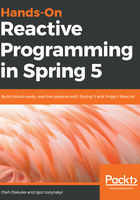
Why Reactive Spring?
In the previous section, we looked at a few interesting examples in which reactive system approaches shine. We have also expanded on the usage of fundamentals such as elasticity and resilience, and seen examples of microservice-based systems commonly used to attain a reactive system.
That gave us an understanding of the architectural perspective but nothing about the implementation. However, it is important to emphasize the complexity of the reactive system and the construction of such a system is a challenge. To create a reactive system with ease, we have to analyze frameworks capable of building such things first and then choose one of them. One of the most popular ways to choose a framework is by analyzing its available features, relevance, and community.
In the JVM world, the most commonly known frameworks for building a reactive system has been Akka and Vert.x ecosystems.
On the one hand, Akka is a popular framework with a huge list of features and a big community. However, at the very beginning, Akka was built as part of the Scala ecosystem and for a long time, it showed its power only within solutions written in Scala. Despite the fact that Scala is a JVM-based language, it is noticeably different from Java. A few years ago, Akka provided direct support for Java, but for some reason, it was not as popular in the Java world as it was in Scala.
On the other hand, there is the Vert.x framework which is also a powerful solution for building an efficient reactive system. Vert.x was designed as a non-blocking, event-driven alternative to Node.js that runs on the Java Virtual Machine. However, Vert.x started being competitive only a few years ago and during the last 15 years, the market for frameworks for flexible robust application development has been held by the Spring Framework.
The Spring Framework provides wide possibilities for building a web application using a developer-friendly programming model. However, for a long time, it had some limitations in building a robust reactive system.